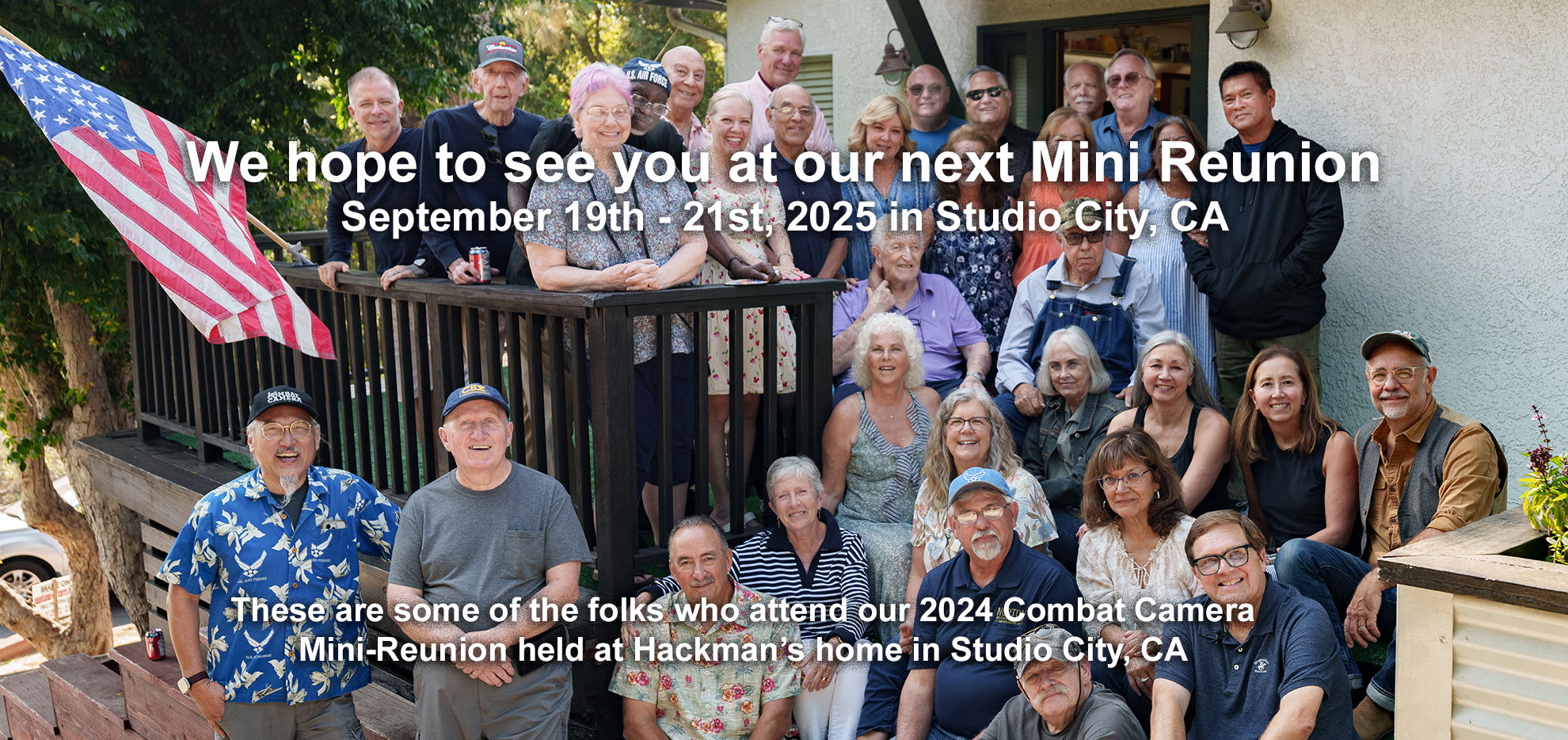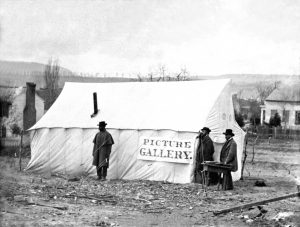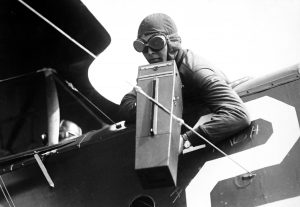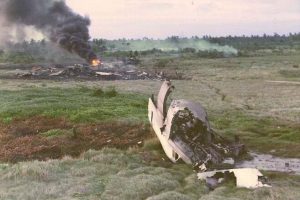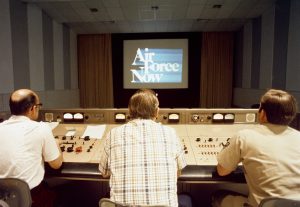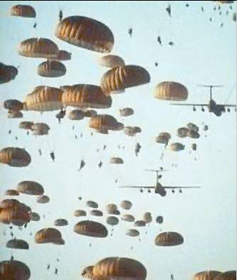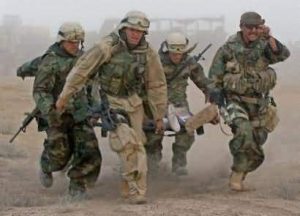AIR FORCE COMBAT CAMERA — AMERICA’S EYES TO THE WORLD
Military and combat photography has a long and storied history that began with early images of war captured by Mathew Brady. Brady and his associates Alexander Gardner, George Barnard, and Timothy O’Sullivan, photographed battlefields, camps, towns and people touched by the war. Since those times, military imagery has not only shaped the social and emotional views of the US military and combat for the average American but has also provided historians, military leaders and politicians a visual record of global activities relating to combat, humanitarian support, training, intelligence and strategic importance. The history of combat camera documentation reflects a long and proud history of visual information service to our service.
In World War 1, our American Airmen flew over 35,000 hours over enemy lines and captured over 18,000 images of enemy positions, from which 585,000 prints were made by photographic sections attached to observation groups. During World War II, the photographic section of the US Army Signal Corps made up only three percent of the Signal Corps.
A more organized visual communication capability emerged in World War II with the activation of the First Motion Picture Unit (FMPU) in Culver City, California in July 1942 from which several Army Air Force Combat Camera Units were born. The First Motion Picture unit was the brainchild of Gen Hap Arnold and film producer Jack Warner. The First Motion Picture Unit (FMPU), later 18th Army Air Forces Base Unit, was the primary film production unit of the US Army Air Forces (USAAF) during World War II and was the first military unit made up entirely of professionals from the film industry. Recognizing the need to quickly produce training films for the Army Corps, Arnold commissioned the first ever military unit formed entirely of motion picture personnel. Notable members of the 1st FMPU included future President Ronald Reagan, Jimmy Stewart, Clark Gable, Jack Warner, Alan Ladd, t George Montgomery, Robert Sterling, William Holden, Lee Cobb, and Arthur Kennedy, to name but a few. Films for which the unit is known include Resisting Enemy Interrogation, Memphis Belle: A Story of a Flying Fortress and The Last Bomb —all of which were released in theaters. The unit also produced training films and one of its primary functions was the training of combat cameramen. http://www.militarymuseum.org/1stmpu.html
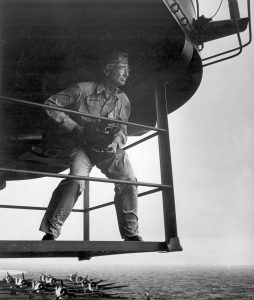
Edward J. Steichen, photographic expert, on island platform, studies his surrounding for one of his outstanding photographs of life aboard an aircraft carrier. Steichen held the rank of Comdr. at this time. Ca. Attributed to Lt. Victor Jorgensen. (Navy)
Combat Camera crews were trained by the First Motion Picture Unit at the Page Military Academy and the training included intensive instruction in photography with a variety of motion picture and still cameras, camera maintenance, aerial photography and cinematography under true flight conditions, rigid physical training, ground combat and weapons training. Each crew was composed of seven officers and 20 to 30 enlisted men. During World War II, fourteen US Army Air Force Combat Camera Units provided still and motion picture coverage of the war in every theater of operations . Their visual record was used for operational analysis, training, public information , and as a permanent historical record. After the war, military photographic units inactivated as the US turned to peacetime duties.
Modern day Combat Camera men and women can trace their roots to the activation of the Aerospace Audiovisual Service (AAVS) in January 1966. As a result of HQ PACAF’s request just a few months earlier, one of AAVS’ first missions was to manage all photographic functions, except reconnaissance, in Southeast Asia, especially during the Vietnam War.
“Project COMBAT PIX” (MORE PIX) began in October 1966, expanding the AAVS mission in Southeast Asia to include all base photo labs, combat documentation and armament recording photography. The 600th Photo Squadron was activated in February 1966. It was formed from the resources of Detachment 5, 1352nd Photo Group but was subordinate directly under HQ AAVS. It was composed of nine detachments throughout Vietnam and the 601st Photo Flight with 6 detachments throughout Thailand. By 1967, as many as 535 personnel were supporting the AAVS photographic and motion picture documentation mission throughout Southeast Asia.
AAVS Headquarters was relocated to Norton AFB, CA in July 1968.
Throughout the 1970s, AAVS still photographers, motion picture photographers and support personnel responded to combat requirements, contingency operations, humanitarian relief efforts and training exercises around the world. In 1973, AAVS crews documented the return of American POWs from Vietnam during Operation HOMECOMING.
Also in 1973, AAVS documented the aerial resupply missions to Israel following simultaneous attacks by Egypt and Syria, also known as the Yom Kippur War. For 32 days, AAVS camera crews documented USAF C-141 and C-5 airlifters carrying urgently needed war materials from points throughout the United States into Lod International Airport at Tel Aviv. They were the only photographers, military or civilian, to cover the entire operation. (Cannot find another reference to this claim other that the AAVS history synopsis in the last AIRCCS Eagle)
On April 4th, 1975, MSgt Joe Castro and SSgt Kenneth Nance, AAVS photographers from the 1369th Audiovisual Squadron were aboard a C-5 Galaxy leaving Saigon’s Tan Son Nhut airport. They were documenting Operation Babylift, the airlift of Vietnamese orphans out of the war-torn country when the aircraft experienced an “explosive rapid decompression.” Before the aircraft crash landed back at Tan Son Nhut Airport, Castro and Nance were last seen setting up their light bars to illuminate and film the evolving tragedy. Both photographers were killed in the crash.
In November of 1978, an AAVS photographer from Detachment 7, 1361st AVS (now 1 CTCS) at Charleston AFB was among the first to document the tragedy at Jonestown, Guyana where over 900 followers of the Rev Jim Jones were massacred. Det. 7 camera crews extensively documented the little known USAF and US Army recovery operations.
By 1983, AAVS assumed centralized responsibility of most overseas installation visual information activities, with squadrons and detachments based in Europe, the Pacific, Asia and Panama. Additionally, AAVS centrally managed regional video production centers as well as dedicated contingency documentation squadrons and detachments throughout the United States. In all, AAVS oversaw seven squadrons: 1352nd Audiovisual Squadron (AVS) at Norton AFB, Calif; 1360th AVS at Offutt AFB, Neb.; 1361st AVS at Charleston AFB, South Carolina; 1363d AVS at Yokota AB, Japan; 1365th AVS at Lackland AFB, Texas, 1367th AVS at Ramstein AB, Germany, and 1369th AVS at Vandenberg AFB, Calif.
In October 1983, AAVS documentation crews traveled to the tiny Caribbean island of Grenada to cover Operation URGENT FURY, which involved the return of medical students and other American citizens. It was AAVS first use of Betacam cameras in a combat contingency. {Additionally, due to an initial lack of a press or media pool, AAVS cameramen provided many of the first images to the American people. This operation also greatly magnified the need for AAVS crews to be physically and mentally fit before deploying with joint task forces.}
By the late 1980’s, AAVS returned to its early roots and adopted the unofficial name “Combat Camera.”
From December 20, 1989 to January 31, 1990, three AAVS squadrons – 1352nd AVS, 1369th AVS and Det. 7, 1361st AVS participated in Operation Just Cause in Panama. These Combat Camera crews documented the entire scope of USAF participation including still and motion aerial documentation of many of the 5000 paratroopers airdropped in the early morning hours of December 20th, 1989. This conflict also saw the first time use of electronic imagery for operational analysis.
The increased use of electronic imagery continued into 1991 as Combat Camera crews recorded Operations DESERT SHIELD and DESERT STORM. Using Sony still video cameras, crews recorded imagery on 2-inch disks. The capability allowed crews to photograph action immediately or, if the mission requires, immediately run to a transmitter that’s hooked to a phone line and transmit material immediately back to Washington, DC – in two minutes.
In January 1990, Combat Camera was officially added to AAVS squadron designations.
AAVS was deactivated on April 1, 1992 and re-designated Air Combat Camera Service (AirCCS). By 1994, AirCCS also deactivated and the remaining Combat Camera squadrons were aligned under two Air Mobility Operations Groups.
In the 1990s and into the 2000s, Combat Camera crews recorded humanitarian aid in Somalia; Desert
Storm/Desert Shield in Kuwait, Iraq and Saudi Arabia; peacekeeping efforts in Bosnia and Herzegovina, Croatia, and Kosovo; Operation Iraqi Freedom and Operation Enduring Freedom in Iraq, Afghanistan and the Southwest Asia region; Hurricanes Katrina and Rita, Unified Assistance (Indian Ocean tsunami), Pakistan Earthquake Relief; and the evacuation of American citizens from Lebanon.
On Oct. 1, 2007, the visual information career fields and functions, including Combat Camera, were merged with the Public Affairs function under the single umbrella of the Secretary of the Air Force Office of Public Affairs. The following year, on Oct. 1, 2008, four Combat Camera squadrons, three active and one reserve, were aligned under the Air Force Public Affairs Agency (AFPAA). As of Oct. 1, 2014, only two Air Force Combat Camera squadrons, the 1st Combat Camera Squadron at Joint Base Charleston and the 3rd Combat Camera Squadron at Joint Base San Antonio-Lackland, remain active.
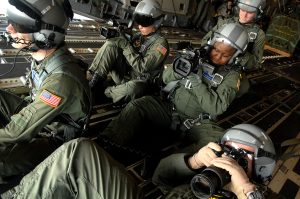
SrA Chalanda Roberts from the 1st Combat Camera squadron, Charleston, SC., photograph C-17 Globemaster III’s from the 437th and 315th Airlift Wing, Charleston AFB, SC., flying in formation over Charleston S.C., on December 18th, 2008 during a strategic brigade airdrop (SBA) exercise involving a 13 multi-ship formation on Dec. 18, 2008. (US Air Force photo by Tech. Sgt. Jeremy Lock) (RELEASED)
Whenever, wherever there is a worldwide crisis or disaster, a contingency or wartime operation or a military exercise involving Air Force, joint or multinational services, the highly skilled professional men and women of Combat Camera are capturing the imagery necessary to support operational needs and provide invaluable visual historical records. By its motto “Global Reach…Global Images,” it is your eyes to the world.
By Renée Tyron, Director of Operations, 1st Combat Camera Squadron
REFERENCES
http://www.militarymuseum.org/1stmpu.html
http://www.archives.gov/education/lessons/brady-photos/
http://www.450thbg.com/real/stories/1stccu.shtml
http://en.wikipedia.org/wiki/Ronald_Reagan#Military_service
http://en.wikipedia.org/wiki/War_photography
http://www.450thbg.com/real/1stccu/index.shtml
http://www.c141heaven.info/dotcom/matsbook/mats_chapter_09.html
http://airforcehistoryindex.org/data/001/112/590.xml
http://archives.nbclearn.com/portal/site/k-12/flatview?cuecard=50092
http://amcmuseum.org/history/airlifts/operation_nickel_grass.php
http://www.atalink.org/ATQ/Issues/ATQ_Spring_2005.pdf
http://www.amc.af.mil/shared/media/document/AFD-131018-047.pdf
http://jonestown.sdsu.edu/?page_id=30369
http://www.charleston.af.mil/shared/media/document/afd-090416-024.pdf
http://airforcehistoryindex.org/data/001/112/590.xml
http://archives.nbclearn.com/portal/site/k-12/flatview?cuecard=50092
On August 22, 2014 A Combat Camera Memorial Bench was dedicated at the National Museum of the United States Air Force on Wright-Patterson AFB, Ohio. This is the dedication video that was produced from the events leading up to during and after the event.

